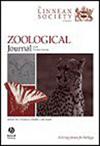Revealing patterns of homoplasy in discrete phylogenetic datasets with a cross-comparable index
IF 2.8
2区 生物学
Q1 ZOOLOGY
引用次数: 0
Abstract
Investigating patterns of homoplasy can improve our understanding of macroevolutionary processes by revealing evolutionary constraints on morphology and highlighting convergent form–function relationships. Here, we test the performance of several widely-used methods that provide measures of homoplasy, including the consistency (CI) and retention indices (RI), using simulated and empirical discrete morphological datasets. In addition, we describe and test a new method employing a novel randomization protocol, which we term the relative homoplasy index (RHI). RHI outperforms other methods in a range of situations for measuring relative homoplasy and allows comparisons between different datasets. In line with some previous work, we show that relative levels of homoplasy remain constant with the addition of characters and decrease with the addition of taxa. We also show that the extent of homoplasy strongly influences the distribution of taxa in morphospace. Low homoplasy results in highly partitioned morphospace, while high homoplasy leads to clades overlapping in morphospace. Our results help illuminate the properties of relative homoplasy in morphological phylogenetic matrices, opening new potential avenues for research on homoplasy quantification in macroevolutionary studies.揭示在具有交叉可比指数的离散系统发育数据集中的同质性模式
通过揭示形态学上的进化约束和强调收敛的形式-功能关系,研究同质性模式可以提高我们对宏观进化过程的理解。在这里,我们测试了几种广泛使用的方法的性能,这些方法提供了同质性的测量,包括一致性(CI)和保留指数(RI),使用模拟和经验离散形态学数据集。此外,我们描述和测试了一种采用新的随机化协议的新方法,我们称之为相对同质性指数(RHI)。RHI在一系列测量相对同质性的情况下优于其他方法,并允许在不同数据集之间进行比较。与之前的一些研究一致,我们发现同源性的相对水平随着性状的增加而保持不变,而随着分类群的增加而降低。我们还表明,同质性的程度强烈地影响着分类群在形态空间中的分布。低同质性导致形态空间高度分割,而高同质性导致枝在形态空间重叠。我们的研究结果有助于阐明形态系统发育基质中相对同源性的特性,为宏观进化研究中同源性定量研究开辟了新的潜在途径。
本文章由计算机程序翻译,如有差异,请以英文原文为准。
求助全文
约1分钟内获得全文
求助全文
来源期刊
CiteScore
6.50
自引率
10.70%
发文量
116
审稿时长
6-12 weeks
期刊介绍:
The Zoological Journal of the Linnean Society publishes papers on systematic and evolutionary zoology and comparative, functional and other studies where relevant to these areas. Studies of extinct as well as living animals are included. Reviews are also published; these may be invited by the Editorial Board, but uninvited reviews may also be considered. The Zoological Journal also has a wide circulation amongst zoologists and although narrowly specialized papers are not excluded, potential authors should bear that readership in mind.

 求助内容:
求助内容: 应助结果提醒方式:
应助结果提醒方式:


